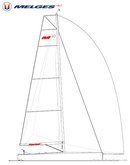Melges 40
Sailboat specifications
The Melges 40 is a 39’4” (11.99m) one design sailboat designed by Botin Partners Naval Architecture (Spain). She is built since 2016 by Melges (United States) and Premier Composite Technologies (United Arab Emirates).
Melges 40's main features
- Model
- Melges 40
- Hull type
- Monohull
- Category
- One design sailboat
- Sailboat builder
- Sailboat designer
- Country
- United States
- Construction
- Carbon fiber reinforced epoxy:
Sandwich carbon fiber epoxy (vacuum infusion) - First built hull
- 2016
- Last built hull
- Still in production
- Appendages
- Canting keel : canting T-shaped keel (with bulb) with central daggeboard
- Helm
- Single tiller
- Rudder
- Twin spade rudders
- Unsinkable
- No
- Trailerable
- No
- EC design categoryiThe CE design category indicates the ability to cope with certain weather conditions (the sailboat is designed for these conditions)
A: Wind < force 9, Waves < 10m
B: Wind < force 8, Waves < 8m
C: Wind < force 6, Waves < 4m
D: Wind < force 4, Waves < 0,5m - B
- Standard public price ex. VAT (indicative only)
- About565 000 €(2016)
Melges 40's main dimensions
- Hull length
- 39’ 4”11.99 m
- Waterline length
- 36’ 5”11.1 m
- Beam (width)
- 11’ 7”3.53 m
- Draft
- 10’ 6”3.2 m
- Light displacement (MLC)
- 7165 lb3250 kg
- Ballast weight
- 2425 lb1100 kg
- Ballast type
- Carbon fiber fin with lead bulb
Melges 40's rig and sails
- Upwind sail area
- 1302 ft²121 m²
- Downwind sail area
- 2928 ft²272 m²
- Mainsail area
- 775 ft²72 m²
- Jib area
- 527 ft²49 m²
- Gennaker area
- 2153 ft²200 m²
- Rigging type
- Ketch Marconi (square top mainsail) 9/10
- Mast configuration
- Deck stepped mast
- Rotating spars
- No
- Number of levels of spreaders
- 2
- Spreaders angle
- Swept-back
- Spars construction
- Carbon fiber spars
- Standing rigging
- Carbon fiber discontinuous
Melges 40's performances
- Crew
- 9 (<680kg)
- Upwind sail area to displacementiThe ratio sail area to displacement is obtained by dividing the sail area by the boat's displaced volume to the power two-thirds.
The ratio sail area to displacement can be used to compare the relative sail plan of different sailboats no matter what their size.
Upwind: under 18 the ratio indicates a cruise oriented sailboat with limited performances especially in light wind, while over 25 it indicates a fast sailboat. - 594 ft²/T55.15 m²/T
- Downwind sail area to displacementiThe ratio sail area to displacement is obtained by dividing the sail area by the boat's displaced volume to the power two-thirds.
The ratio sail area to displacement can be used to compare the relative sail plan of different sailboats no matter what their size. - 1334 ft²/T123.97 m²/T
- Displacement-length ratio (DLR)iThe Displacement Length Ratio (DLR) is a figure that points out the boat's weight compared to its waterline length. The DLR is obtained by dividing the boat's displacement in tons by the cube of one one-hundredth of the waterline length (in feet).
The DLR can be used to compare the relative mass of different sailboats no matter what their length:
a DLR less than 180 is indicative of a really light sailboat (race boat made for planning), while a DLR greater than 300 is indicative of a heavy cruising sailboat. - 67
- Ballast ratioiThe Ballast ratio is an indicator of stability; it is obtained by dividing the boat's displacement by the mass of the ballast. Since the stability depends also of the hull shapes and the position of the center of gravity, only the boats with similar ballast arrangements and hull shapes should be compared.
The higher the ballast ratio is, the greater is the stability. - 34 %
- Critical hull speediAs a ship moves in the water, it creates standing waves that oppose its movement. This effect increases dramatically the resistance when the boat reaches a speed-length ratio (speed-length ratio is the ratio between the speed in knots and the square root of the waterline length in feet) of about 1.2 (corresponding to a Froude Number of 0.35) . This very sharp rise in resistance, between speed-length ratio of 1.2 to 1.5, is insurmountable for heavy sailboats and so becomes an apparent barrier. This leads to the concept of "hull speed".
The hull speed is obtained by multiplying the square root of the waterline length (in feet) by 1.34. - 8.09 knots
Melges 40's auxiliary engine
- Engine(s)
- 1 inboard engine
- Engine(s) power
- 20 HP
- Fuel type
- Diesel
- Fuel tank capacity
- 10.6 gal40 liters
Melges 40's accommodations and layout
- Cockpit
- Open aft cockpit











Melges 40 interior and accommodations - - 10/11
Picture extracted from the commercial documentation © Melges
Picture extracted from the commercial documentation © Melges

Similar sailboats that may interest you:
Sailboats
First built hull
Hull length
2010
33’ 11”10.34 m
2003
33’ 2”10.11 m
2016
50’15.24 m
2007
40’12.18 m
2014
40’12.19 m
2017
32’9.75 m
2014
40’12.18 m
2009
40’12.18 m
2017
40’12.2 m
2010
38’ 8”11.8 m
2014
40’12.2 m
2019
37’ 1”11.3 m
2014
32’ 10”9.99 m
2019
36’ 1”11 m
2005
31’ 10”9.7 m